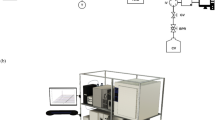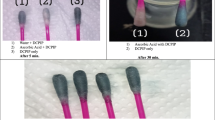Abstract
Lupeol is the main active constituent of Hygrophila schulli (HS) plant. A simple, reliable and reproducible method of quantification is needed for the quality control of HS. Therefore, high-performance thin-layer chromatography (HPTLC) method was established for determining lupeol in HS roots and aerial parts. The laboratory isolated and identified (by UV, FT-IR, 1H- and 13C-NMR and MS) lupeol from HS roots was used to develop the proposed method. The method was validated in terms of linearity, limits of detection and quantification, stability, precision, accuracy and robustness studies. Aluminum-backed HPTLC plates precoated with silica gel 60F254 were used as the stationary phase and benzene‒chloroform‒methanol (93:5.75:1.25, V/V) as the optimized mobile phase. Post-chromatographic derivatization was done with anisaldehye‒H2SO4 reagent, and the chromatograms were scanned using CAMAG TLC Scanner III at 540 nm. The linear regression analysis data for the calibration plots of lupeol showed good linearity relationship with y = 7.1841x + 751.42 (r2 = 0.9979) regression equation in the concentration range of 200–1000 ng band−1 (RF = 0.43 ± 0.02). Mean ± SD values of slope and intercept were 7.1840 ± 0.067 and 751.42 ± 45.50, respectively. The stability study suggested that lupeol in chloroform was stable within 24 h at room temperature (%RSD = 1.07). The average percentage recovery of lupeol from the petroleum ether extracts of HS roots and aerial parts was 98.66 ± 0.65 and 98.77 ± 0.39, respectively, with a % w/w content 5.02 ± 0.23 and 0.39 ± 0.11% w/w on dry weight basis. The limits of detection and quantification were found to be 17.85 and 54.11, respectively.


Similar content being viewed by others
References
Cook CDK (1996) Aquatic plant book. SPB Academic Publishing, Amsterdam
Almeida MR, Almeida SM (1986) Identity of Bahel schulli of Hortus malabaricus. J Bombay Nat Hist Soc 83:221–222
Khare CP (2014) Encyclopedia of Indian medicinal plants -rationale western therapy, ayurvedic and other traditional usage, botany. Springer, Berlin
Chopra RN, Nayar SL, Chopra IC (1966) Glossary of Indian medicinal plants. Council of Scientific and Industrial Research, New Delhi
Nguta JM, Appiah-Opong R, Nyarko AK et al (2015) Medicinal plants used to treat TB in Ghana. Int J Mycobacteriol 4:116–123. https://doi.org/10.1016/j.ijmyco.2015.02.003
Boily Y, Van Puyvelde I (1986) Screening of medicinal plants of Rwanda (Central Africa) for antimicrobial activity. J Ethnopharmacol 16:1–13. https://doi.org/10.1016/0378-8741(86)90062-0
Vlietinck AJ, Van Hoof L, Totté J et al (1995) Screening of hundred Rwandese medicinal plants for antimicrobial and antiviral properties. J Ethnopharmacol 46:31–47. https://doi.org/10.1016/0378-8741(95)01226-4
Singh MP, Panda H (2005) Medicinal herbs with their formulations. Daya Publishing House, New Delhi
Sivarajan VV, Balachandran I (1994) Ayurvedic drugs and their plant sources. Oxford and IBH Publishing Co. Pvt. Ltd., Delhi
Sethiya NK, Ahmed NM, Shekh RM et al (2018) Ethnomedicinal, phytochemical and pharmacological updates on Hygrophila auriculata (Schum.) Hiene: an overview. J Integr Med 16:299–311. https://doi.org/10.1016/j.joim.2018.07.002
Fernando MR, Wickramasinghe N, Thabrew MI et al (1989) A preliminary investigation of the possible hypoglycaemic activity of Asteracanthus longifolia. J Ethnopharmacol 27:7–14. https://doi.org/10.1016/0378-8741(89)90072-x
Hewawasam RP, Jayatilaka KAPW, Pathirana C et al (2003) Protective effect of Asteracantha longifolia extract in mouse liver injury induced by carbon tetrachloride and paracetamol. J Pharm Pharmacol 55:1413–1418. https://doi.org/10.1211/0022357021792
Kanhere R, Anjana A, Anbu J et al (2013) Neuroprotective and antioxidant potential of terpenoid fraction from Hygrophila auriculata against transient global cerebral ischemia in rats. Pharm Biol 51:181–189. https://doi.org/10.3109/13880209.2012.716851
Uddin SJ, Grice ID, Tiralongo E (2011) Cytotoxic effects of Bangladeshi medicinal plant extracts. Evid Based Complement Alternat Med 2011:578092. https://doi.org/10.1093/ecam/nep111
Palani V, Senthilkumaran RK, Govindasamy S (1999) Biochemical evaluation of antitumor effect of Muthu Marunthu (a herbal formulation) on experimental fibrosarcoma in rats. J Ethnopharmacol 65:257–265. https://doi.org/10.1016/s0378-8741(98)00159-7
Patra A, Jha S, Murthy PN et al (2009) Anti-inflammatory and antipyretic activities of Hygrophila spinosa T. Anders Leaves (Acanthaceae). Trop J Pharm Res 8:133–137. https://doi.org/10.4314/tjpr.v8i2.44521
Hussain MS, Azam F, Nazeer Ahamed KFH et al (2016) Anti-endotoxin effects of terpenoids fraction from Hygrophila auriculata in lipopolysaccharide-induced septic shock in rats. Pharm Biol 54:628–636. https://doi.org/10.3109/13880209.2015.1070877
Zihad SMNK, Gupt Y, Uddin SJ et al (2019) Nutritional value, micronutrient and antioxidant capacity of some green leafy vegetables commonly used by southern coastal people of Bangladesh. Heliyon 5:e02768. https://doi.org/10.1016/j.heliyon.2019.e02768
Surveswaran S, Cai YZ, Corke H et al (2007) Systematic evaluation of natural phenolic antioxidants from 133 Indian medicinal plants. Food Chem 102:938–953. https://doi.org/10.1016/j.foodchem.2006.06.033
Vijayakumar M, Govindarajan R, Rao GMM et al (2006) Action of Hygrophila auriculata against streptozotocin-induced oxidative stress. J Ethnopharmacol 104:356–361. https://doi.org/10.1016/j.jep.2005.09.030
Mazumdar UK, Gupta M, Maiti S (1999) Chemical and pharmacological evaluation of Hygrophila spinosa root. Indian J Pharm Sci 61:181–183
Shanmugasundaram P, Venkataraman S (2006) Hepatoprotective and antioxidant effects of Hygrophila auriculata (K. Schum) Heine Acanthaceae root extract. J Ethnopharmacol 104:124–128. https://doi.org/10.1016/j.jep.2005.08.058
Mazumdar UK, Gupta M, Maiti S et al (1997) Antitumor activity of Hygrophila spinosa on Ehrlich ascites carcinoma and sarcoma-180 induced mice. Indian J Exp Biol 35:473–477 PMID:9378516
Maiti B (1994) Antineoplastic effects of the root extract of Hygrophila spinosa. In: Proceedings of the international conference on current progress in medicinal and aromatic plant research, Calcutta
SinghA Handa SS (1995) Hepatoprotective activity of Apium graveolens and Hygrophila auriculata against paracetamol and thioacetamide intoxication in rats. J Ethnopharmacol 49:119–126. https://doi.org/10.1016/0378-8741(95)01291-5
Kannur D, Nandanwadkar S, Dhawane S et al (2017) Experimental evaluation of Hygrophila schulli seed extracts for antistress activity. Ancient Sci Life 37:31–36. https://doi.org/10.4103/asl.ASL_191_17
Ghosh C, Mallick C (2019) Protective effect of ethanolic extract of Hygrophila auriculata seeds in cyproterone acetate-induced sexual dysfunction in male albino rats. Andrologia 00:e13482. https://doi.org/10.1111/and.13482
Kumar S, Ziereis K, Wiegrebe W et al (2000) Medicinal plants from Nepal: evaluation as inhibitors of leukotriene biosynthesis. J Ethnopharmacol 70:191–195. https://doi.org/10.1016/s0378-8741(00)00203-8
Ahmed S, Rahman A, Mathur M et al (2001) Anti-tumor promoting activity of Asteracantha longifolia against experimental hepatocarcinogenesis in rats. Food Chem Toxicol 39:19–28. https://doi.org/10.1016/s0278-6915(00)00103-4
Bairaj P, Nagarajan S (1982) Apigenin-7-O-glucuronide from the flowers of Asteracantha longifolia Nees. Indian Drugs 19:150–152
Hussain MS, Fareed S, Ali M (2012) Simultaneous HPTLC‒UV530 nm analysis and validation of bioactive lupeol and stigmasterol in Hygrophila auriculata (K. Schum) Heine. Asian Pac J Trop Biomed S612–S617. https://doi.org/10.1016/S2221-1691(12)60283-4
Parashar VV, Singh H (1965) Investigation of Astercantha longifolia Nees. Indian J Pharmacol 27:109–113
Govindachari TR, Nagarajan K, Pai BR (1957) Isolation of lupeol from the root of Asteracantha longifolia Nees. J Indian Sci Res 16:72–77
Gupta DR, Bhushan R, Dhiman RP et al (1982) Chemical examination of Asteracantha longifolia. J Nat Prod 46:938. https://doi.org/10.1021/np50030a023
Basu NK, Rakhit S (1957) Investigation of the seeds of Asteracantha longifolia Nees. Indian J Pharm 19:285–288
Quasim C, Dutta NL (1967) Presence of stigmasterol in the root of Asteracantha longifolia Nees. J Indian Chem Soc 44:82
Misra TN, Singh RS, Pandey HS et al (2001) Constituents of Asteracantha longifolia. Fitoterapia 72:194–196. https://doi.org/10.1016/s0367-326x(00)00269-0
Hussain MS, Gebira HM, Ismail H et al (2019) New aliphatic ester constituents of Hygrophila auriculata (K. Schum) Heine from the Koshi river basin. Orient Pharm Exp Med 19:251–258. https://doi.org/10.1007/s13596-018-0336-8
Godbole NN, Gunde BG, Srivastava PD (1941) An investigation of oil from seed of Hygrophila spinosa. Oil Soap 18:206–207. https://doi.org/10.1007/BF02544184
Kar A, Choudhary BK, Bandyopdhyay NB (1998) Important mineral contents and medicinal properties of Moringa oleifera and Hygrophila spinosa. Sachitra Ayurveda 50:543–549
Sengupta SR, Pal B (1970) Composition of edible wild greens. J Sci Food Agric 21:215. https://doi.org/10.1002/jsfa.2740210412
Jayaprakasam R, Ravi TK (2019) In vitro screening of the biological activity of combined extracts of two medicinal plants and their standardization by validated analytical methods using standard markers. J Pharmacogn Phytochem 8:2305–2312. E-ISSN:2278-4136
Vyas N, Raval M (2015) Quantification of two marker compounds from unsaponifiable matter of Hygrophila spinosa seeds using validated TLC-densitometric method. Int J Pharm Res 7:39–46
ICH, Q2(R1) (1996) Validation of Analytical Procedure: Methodology.In: Proceeding of the International Conference on Harmonization, Geneva. https://database.ich.org/sites/default/files/Q2%28R1%29%20Guideline.pdf. Accessed Nov 2019
Reich E, Schibli A (2007) High-performance thin-layer chromatography for the analysis of medicinal plants. Thieme Medical Publishers, New York
Desai NS, Barhate CR, Biyani SO et al (2011) Quantitative analysis of flavonoids in Annona squamosa leaf extracts and its pellet formulation by validated high-performance thin-layer chromatographic technique. J Planar Chromatogr 24:306–311. https://doi.org/10.1556/jpc.24.2011.4.6
Sawant LP, Prabhakar BR, Pandita NS (2011) HPTLC method for quantification of isovitexin in the whole-plant powder of Enicostemma littorale Blume. J Planar Chromatogr 24:301–305. https://doi.org/10.1556/jpc.24.2011.4.5
Srivastava P, Jyotshna Gupta N et al (2014) New anti-inflammatory triterpene from the root of Ricinus communis. Nat Prod Res 28:306–311. https://doi.org/10.1080/14786419.2013.861834
Deyrup ST, Asghar KB, Chacko A et al (2014) Chemical investigation of the medicinal and ornamental plant Angelonia angustifolia Benth. reveals therapeutic quantities of lupeol. Fitoterapia 98:174–178. https://doi.org/10.1016/j.fitote.2014.08.005
Sethiya NK, Mishra S (2015) Simultaneous HPTLC analysis of ursolic acid, betulinic acid, stigmasterol and lupeol for the identification of four medicinal plants commonly available in the Indian market as Shankhpushpi. J Chromatogr Sci 53:816–823. https://doi.org/10.1093/chromsci/bmu111
Irshad S, Khatoon S (2018) Development of a validated high-performance thin-layer chromatography method for the simultaneous estimation of caffeic acid, ferulic acid, β-sitosterol, and lupeol in Convolvulus pluricaulis choisy and its adulterants/substitutes. J Planar Chromatogr 31:429–436. https://doi.org/10.1556/1006.2018.31.6.2
Katakam S, Sharma P, Anandjiwala S et al (2019) Investigation on apposite chemical marker for quality control of Tephrosia purpurea (L.) Pers. by means of HPTLC-chemometric analysis. J Chromatogr B 1110–1111:81–86. https://doi.org/10.1016/j.jchromb.2019.02.006
Chauhan S, Sharma A, Upadhyay NK et al (2018) In-vitro osteoblast proliferation and in vivo anti-osteoporotic activity of Bombax ceiba with quantification of lupeol, gallic acid and β-sitosterol by HPTLC and HPLC. BMC Complement Altern Med 18:233. https://doi.org/10.1186/s12906-018-2299-1
Acknowledgements
The authors gratefully acknowledge Sophisticated Analytical Instrument Facility (SAIF), Punjab University, Chandigarh, India, for providing the results on spectral analysis (1H- and 13C-NMR, EIMS) of lupeol.
Author information
Authors and Affiliations
Contributions
BG had designed the work, isolated and identified lupeol from HS roots. PA and PL assisted to perform the experiment while DK and NK evaluated the data and helped to prepare this article.
Corresponding author
Ethics declarations
Conflicts of interest
The authors declare no conflict of interest that are relevant to the content of this article.
Electronic supplementary material
Below is the link to the electronic supplementary material.
Rights and permissions
About this article
Cite this article
Ghule, B., Agrawal, P., Lal, P. et al. Separation and quantification of lupeol in Hygrophila schulli by high-performance thin-layer chromatography. JPC-J Planar Chromat 34, 79–87 (2021). https://doi.org/10.1007/s00764-021-00079-8
Received:
Accepted:
Published:
Issue Date:
DOI: https://doi.org/10.1007/s00764-021-00079-8




